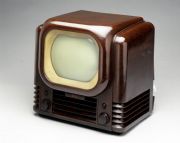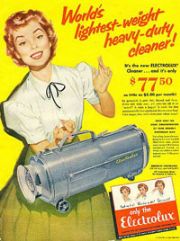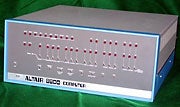The 7 Worst Tech Predictions of All Time
Who said I think there is a world market for maybe five computers?
IBM's first large-scale digital calculating machine, the Selective Sequence Electronic Calculator (SSEC), is announced. The SSEC is the first computer that can modify a stored program, and featured 12,000 vacuum tubes and 21,000 electromechanical relays.
IBM introduces the IBM 604 Electronic Calculating Punch. The mass-produced 604 features the industry's first assemblage of digital electronics replaceable as a unit. Service engineers can simply pull out a defective unit of the 604 and plug in a replacement, reducing downtime.
Predicting the future ain't easy. That's why astrologers and fortune tellers tend to keep their forecasts as vague as possible. But in the high-stakes world of high technology, the future belongs to those who see it coming well in advance.
Of course, even the most successful tech prognosticators make their share of foolish predictions, multiplying the candidates for inclusion in this article. In any case, here are a few of my favorite forward-looking flubs of the past 65 years.
Foolish Tech Prediction 1
"I think there is a world market for maybe five computers."
Thomas Watson, president of IBM, 1943

At the dawn of the computer industry, nobody really knew where this new technology would take us. But the explosion of desktop computing that put a PC in nearly every American home within 50 years seems to have eluded the imagination of most mid-century futurists.
After all, when IBM's Thomas Watson said "computer," he meant "vacuum-tube-powered adding machine that's as big as a house." It's fair to say that few people ever wanted one of those, regardless of the size of their desk.
(IBM did stay in the business, of course. For details, see our retrospective, "The IBM Personal Computer's 25th Anniversary.")
Thomas John Watson Sr. (February 17, 1874 – June 19, 1956) was an American businessman. He served as the chairman and CEO of International Business Machines (IBM)[1][2] He oversaw the company's growth into an international force from 1914 to 1956. Watson developed IBM's management style and corporate culture from John Henry Patterson's training at NCR.[3] He turned the company into a highly-effective selling organization, based largely on punched card tabulating machines. A leading self-made industrialist,[4] he was one of the richest men of his time and was called the world's greatest salesman when he died in 1956. Thomas J. Watson was the fifth child and only son of Thomas and Jane Fulton White Watson.[5] His four older siblings were all girls —Jennie, Effie, Loua, and Emma. His father farmed and owned a modest lumber business located near Painted Post, a few miles west of Elmira, in the Southern Tier region of New York.[6] Thomas worked on the family farm in East Campbell, New York and attended the District School Number Five in the late 1870s.[7] As Watson entered his teen years he attended Addison Academy In Addison, New York.[6]
Having given up his first job—teaching—after just one day, Watson took a year's course in accounting and business at the Miller School of Commerce in Elmira. He left the school in 1891, taking a job at $6 a week as bookkeeper for Clarence Risley's Market in Painted Post. One year later he joined a traveling salesman, George Cornwell, peddling organs and pianos around the farms for William Bronson's local hardware store, Watson's first sales job. When Cornwell left, Watson continued alone, earning $10 per week. After two years of this life, he realized he would be earning $70 per week if he were on a commission. His indignation on making this discovery was such that he quit and moved from his familiar surroundings to the relative metropolis of Buffalo.[6]
Watson then spent a very brief period selling sewing machines for Wheeler and Wilcox. According to Tom Watson, Jr., in his autobiography:
Watson would later enforce strict rules at IBM against alcohol consumption, even off the job. According to Tom Jr.:
Watson's next job was peddling shares of the Buffalo Building and Loan Company for a huckster named C. B. Barron, a showman renowned for his disreputable conduct, which Watson, as a lifelong Methodist, deplored. Barron absconded with the commission and the loan funds. Next Watson opened a butcher shop in Buffalo, which soon failed, leaving Watson with no money, no investment, and no job.[4]
Watson had a newly acquired NCR cash register in his butcher shop, for which he had to arrange transfer of the installment payments to the new owner of the butcher shop. On visiting NCR, he met John J. Range and asked him for a job. Determined to join the company, he repeatedly called on Range until, after a number of abortive attempts, he finally was hired in November, 1896, as sales apprentice to Range.[6]
Led by John Patterson, NCR was then one of the leading selling organizations, and John J. Range, its Buffalo branch manager, became almost a father figure for Watson and was a model for his sales and management style. Certainly in later years, in a 1952 interview, he claimed he learned more from Range than anyone else. But at first, he was a poor salesman, until Range took him personally in hand. Then he became the most successful salesman in the East, earning $100 per week.
Four years later, NCR assigned Watson to run the struggling NCR agency in Rochester, New York. As an agent, he got 35% commission and reported directly to Hugh Chalmers, the second-in-command at NCR. In four years Watson made Rochester effectively an NCR monopoly by using the technique of knocking the main competitor, Hallwood, out of business, sometimes resorting to sabotage of the competitor's machines.[6] As a reward he was called to the NCR head office in Dayton, Ohio.[4]
In 1912, the company was found guilty of violating the Sherman Antitrust Act. Patterson, Watson, and 26 other NCR executives and managers were convicted for illegal anti-competitive sales practices and were sentenced to one year of imprisonment. Their convictions were unpopular with the public because of the efforts of Patterson and Watson to help those affected by the Dayton, Ohio floods of 1913, but efforts to have them pardoned by President Woodrow Wilson were unsuccessful. However, their convictions were overturned on appeal in 1915 on the grounds that important defense evidence should have been admitted.
Charles Ranlett Flint who had engineered the consolidation forming the Computing-Tabulating-Recording Company (CTR) found it difficult to manage. He hired Watson as general manager on May 1, 1914 when the subsidiary companies had about 1,300 employees. Eleven months later he was made president when court cases relating to his time at NCR were resolved.[9] Within four years revenues had been doubled to $9 million.[10] In 1924, he renamed the company International Business Machines. Watson built IBM into such a dominant company that the federal government filed a civil antitrust suit against it in 1952. IBM owned and leased to its customers more than 90 percent of all tabulating machines in the United States at the time. When Watson died in 1956, IBM's revenues were $897 million, and the company had 72,500 employees.[11]
Throughout his life, Watson maintained a deep interest in international relations, from both a diplomatic and a business perspective. He was known as President Roosevelt's unofficial ambassador in New York and often entertained foreign statesmen. In 1937, he was elected president of the International Chamber of Commerce (ICC) and at that year's biennial congress in Berlin stated the conference keynote to be "World Peace Through World Trade".[12] That phrase became the slogan of both the ICC and IBM.[13] Watson's merger of diplomacy and business was not always lauded. During the 1930s, IBM's German subsidiary was its most profitable foreign operation, and a 2001 book by Edwin Black, IBM and the Holocaust, argues that Watson's pursuit of profit led him to personally approve and spearhead IBM's strategic technological relationship with Nazi Germany.[14] In particular, critics point to the coveted Order of the German Eagle medal that Watson received at the Berlin ICC meeting in 1937, as evidence that he was being honored for the help that IBM's German subsidiary Dehomag (Deutsche Hollerith-Maschinen Gesellschaft mbH) and its punch card machines provided the Nazi regime, particularly in the tabulation of census data (i.e. location of Jews). Another study, argues that Watson believed, perhaps naively, that the medal was in recognition of his years of labor on behalf of global commerce and international peace.[6] Within a year of the Berlin congress though, where Watson's hopes had run high, he found himself strongly protesting the German policy toward the Jews. Because of his strong feelings about the issue, Watson wanted to return his German citation shortly after receiving it. When Secretary of State Hull advised him against that course of action, he gave up the idea until the spring of 1940. Then Hull refused advice, and Watson sent the medal back in June 1940. [15] Dehomag's management disapproved of Watson's action and considered separating from IBM. This occurred when Germany declared war on the United States in December 1941, and the German shareholders took custody of the Dehomag operation.[6] But during World War II, IBM subsidiaries in occupied Europe never stopped delivery of punch cards to Dehomag, and documents uncovered show that senior executives at IBM world headquarters in New York took great pains to maintain legal authority over Dehomag's operations and assets through the personal intervention of IBM managers in neutral Switzerland, directed via personal communications and private letters.[14]
During this same period, IBM became more deeply involved in the war effort for the U.S., focusing on producing large quantities of data processing equipment for the military and experimenting with analog computers. Watson, Sr. also developed the "1% doctrine" for war profits which mandated that IBM receive no more than 1% profit from the sales of military equipment to U.S. Government.[16] Watson was one of the few CEOs to develop such a policy.
In 1941, Watson received the third highest salary and compensation package in the U.S., $517,221, on which he paid 69% in tax.[17]
Watson had a personal interest in the progress of the war. His eldest son, Thomas J. Watson Jr., joined the United States Army Air Corps where he became a bomber pilot. But he was soon hand-picked to become the assistant and personal pilot for General Follet Bradley, who was in charge of all Lend-Lease equipment supplied to the Soviet Union from the United States. Watson, Sr.'s youngest son, Arthur K. Watson, also joined the military during the conflict.
Watson worked with local leaders to create a college in the Binghamton area, where IBM was founded and had major plants. In 1946, IBM provided land and funding for Triple Cities College, an extension of Syracuse University. Later it became known as Harpur College, and eventually evolved into Binghamton University. Its School of Engineering and Applied Sciences is named the Thomas J. Watson School of Engineering and Applied Sciences. The IBM plant in the neighboring city of Endicott has since downsized drastically, however.
After World War II, Watson began work to further the extent of IBM's influence abroad and in 1949, he created the IBM World Trade Corporation in order to oversee IBM's foreign business.[18]
On May 8, 1956 Watson retired and his oldest son, Thomas J. Watson, Jr assumed the position of CEO.[19] He died on June 19, 1956 in Manhattan, New York City.[1] He was interred in Sleepy Hollow Cemetery in Sleepy Hollow, New York.
Watson married Jeanette Kittredge, from a prominent Dayton, Ohio railroad family, on April 17, 1913. They had two sons and two daughters.
- Thomas Watson, Jr. succeeded his father as IBM chairman and later served as ambassador to the Soviet Union under Jimmy Carter
- Jeanette Watson Irwin married businessman John N. Irwin II, later ambassador to France
- Helen Watson Buckner became an important philanthropist in New York City
- Arthur K. Watson served as president of IBM World Trade Corporation and later, as ambassador to France
As a Democrat (after his criminal indictment by the Taft Administration), Watson was an ardent supporter of Roosevelt. He was one of the most prominent businessmen in the Democratic Party. He was considered Roosevelt's strongest supporter in the business community.[citation needed]
In 1936 the U.S. Supreme Court upheld a lower court decision that IBM, together with Remington Rand, should cease its practice of requiring its customers to buy their punch cards from it alone. The ruling made little difference because IBM was the only effective supplier to the market, and profits continued undiminished.[4]
Watson served as a powerful trustee of Columbia University from June 6, 1933 until his death. He engineered the selection of Dwight D. Eisenhower as its president and played the central role in convincing Eisenhower to become president of the university. Additionally, he served as a trustee of Lafayette College and is the namesake of Watson Hall, a campus residence hall. [20]
In 1939, he received an honorary degree in Doctor of Commercial Science from Oglethorpe University.[21]
In the 1940s, Watson was on the national executive board of the Boy Scouts of America and served for a time as international Scout commissioner. E. Urner Goodman recounts that the elderly Watson attended an international Scout commissioners' meeting in Switzerland, where the IBM founder asked not to be put on a pedestal. Before the conference was over, Goodman relates, Watson "... sat by that campfire, in Scout uniform, 'chewing the fat' like the rest of the boys".[22] He received the Silver Buffalo Award in 1944. His son, Thomas Jr., later served as National president of the Boy Scouts of America from 1964 to 1968.
Watson was chairman of the Elmira College centennial committee in 1955 and donated Watson Hall, primarily a music and mathematics academic building.
Although Watson is well known for his alleged 1943 statement, "I think there is a world market for maybe five computers," there is scant evidence he said it. Author Kevin Maney tried to find the origin of the quote, but has been unable to locate any speeches or documents of Watson's that contain this, nor are the words present in any contemporary articles about IBM. One of the very first attributions may be found in The Experts Speak, a book written by Christopher Cerf and Victor S. Navasky in 1984, however Cerf and Navasky just quote from a book written by Morgan and Langford, Facts and Fallacies. Another early article source (May 15, 1985) is a column by Neil Morgan, a San Diego Evening Tribune writer who wrote: "Forrest Shumway, chairman of The Signal Cos., doesn't make predictions. His role model is Tom Watson, then IBM chairman, who said in 1958: 'I think there is a world market for about five computers.'" The earliest known citation on the Internet is from 1986 on Usenet in the signature of a poster from Convex Computer Corporation as "'I think there is a world market for about five computers' —Remark attributed to Thomas J. Watson (Chairman of the Board of International Business Machines), 1943". All these early quotes are questioned by Eric Weiss, an editor of the Annals of the History of Computing in ACS letters in 1985.[24][full citation needed]
There are documented versions of similar quotes by other people in the early history of the computer. In 1946 Sir Charles Darwin (grandson of the famous naturalist), head of Britain's NPL (National Physical Laboratory), where research into computers was taking place, wrote:
In 1985 the story was discussed on Usenet (in net.misc), without Watson's name being attached. The original discussion has not survived, but an explanation has; it attributes a very similar quote to the Cambridge mathematician Professor Douglas Hartree, around 1951:
Howard H. Aiken made a similar statement in 1952:
The story already had been described as a myth in 1973; the Economist quoted a Mr. Maney as "revealing that Watson never made his oft-quoted prediction that there was 'a world market for maybe five computers.'" [30]
Since the attribution typically is used to demonstrate the fallacy of predictions, if Watson had made such a prediction in 1943, then, as Gordon Bell pointed out in his ACM 50 years celebration keynote, it would have held true for some ten years.[31]
The IBM archives of Frequently Asked Questions[32] notes an inquiry about whether he said in the 1950s that he foresaw a market potential for only five electronic computers. The document says no, but quotes his son and then IBM President Thomas J. Watson, Jr., at the annual IBM stockholders meeting, April 28, 1953, as speaking about the IBM 701 Electronic Data Processing Machine, which it identifies as "the company's first production computer designed for scientific calculations". He said that "IBM had developed a paper plan for such a machine and took this paper plan across the country to some 20 concerns that we thought could use such a machine. I would like to tell you that the machine rents for between $12,000 and $18,000 a month, so it was not the type of thing that could be sold from place to place. But, as a result of our trip, on which we expected to get orders for five machines, we came home with orders for 18." Watson, Jr., later gave a slightly different version of the story in his autobiography, where he said the initial market sampling indicated 11 firm takers and 10 more prospective orders.[8]
"THINK" - Watson began using "THINK" to motivate, or inspire, staff while at NCR and continued to use it at CTR. International Business Machines's first U.S. trademark was for the name "THINK" filed as a U.S. trademark on June 6, 1935, with the description "periodical publications". This trademark was filed fourteen years before the company filed for a U.S. trademark on the name IBM. A biographical article in 1940 noted that "This word is on the most conspicuous wall of every room in every IBM building. Each employee carries a THINK notebook in which to record inspirations. The company stationery, matches, scratch pads all bear the inscription, THINK. A monthly magazine called 'Think' is distributed to the employees."[33] THINK remains a part of IBM's corporate culture; it was the inspiration behind naming IBM's successful line of notebook computers, IBM ThinkPad.[34] In 2007, IBM Mid America Employees Federal Credit Union changed its name to Think Mutual Bank.
Foolish Tech Prediction 2
"Television won't be able to hold on to any market it captures after the first six months. People will soon get tired of staring at a plywood box every night."
Darryl Zanuck, executive at 20th Century Fox, 1946

By 1946, movie executive Darryl Zanuck had already cemented his place in entertainment history as the producer of more than 100 films for the big silver screen. So who could have blamed him for underestimating the power of the small blue screen? I'm guessing that if Zanuck were alive today, he'd find himself just as mesmerized as the rest of us by the mind-crushing distortion loop that modern TV programming has become.
Foolish Tech Prediction 3
"Nuclear-powered vacuum cleaners will probably be a reality within ten years."
Alex Lewyt, president of Lewyt vacuum company, 1955

In the 1950s, the only thing more certain than the red menace was the inevitability of atomic power. So when New Jersey-based vacuum cleaner honcho Alex Lewyt heralded a tomorrow in which nuclear-powered appliances would suck up dirt in every American household, the news probably caused few eyebrows to rise. Remember, this was the era of radium-impregnated paint for glow-in-the-dark dials. Peaceful radioactivity seemed as safe as asbestos.
Of course, Lewyt's vision has yet to come true, and it likely won't until well after nuclear reactors are enlisted to power all of the terminator robots in our post-SkyNet future.
(Interested in robots? Take a look at "The Robots of 2008" for a video appreciation of the coolest and most innovative of Gort's great-great-grandchildren.)
Foolish Tech Prediction 4
"There is no reason anyone would want a computer in their home."
Ken Olsen, founder of Digital Equipment Corporation, 1977

Digital Equipment Corporation was acquired by Compaq more than a decade ago, but in the 1970s the company was a major force in the world of computing. Apologists argue that DEC president Ken Olsen made this quip before the advent of the PC as we know it, but ready-made personal computers like the MITS Altair had hit the market a couple of years earlier. And within four years of Olsen's remark, the release of the IBM PC had enshrined this prediction in the high-tech hall of shame.
(The MITS Altair 8800 pictured above is one of "The Most Collectible PCs of All Time.")






No comments:
Post a Comment